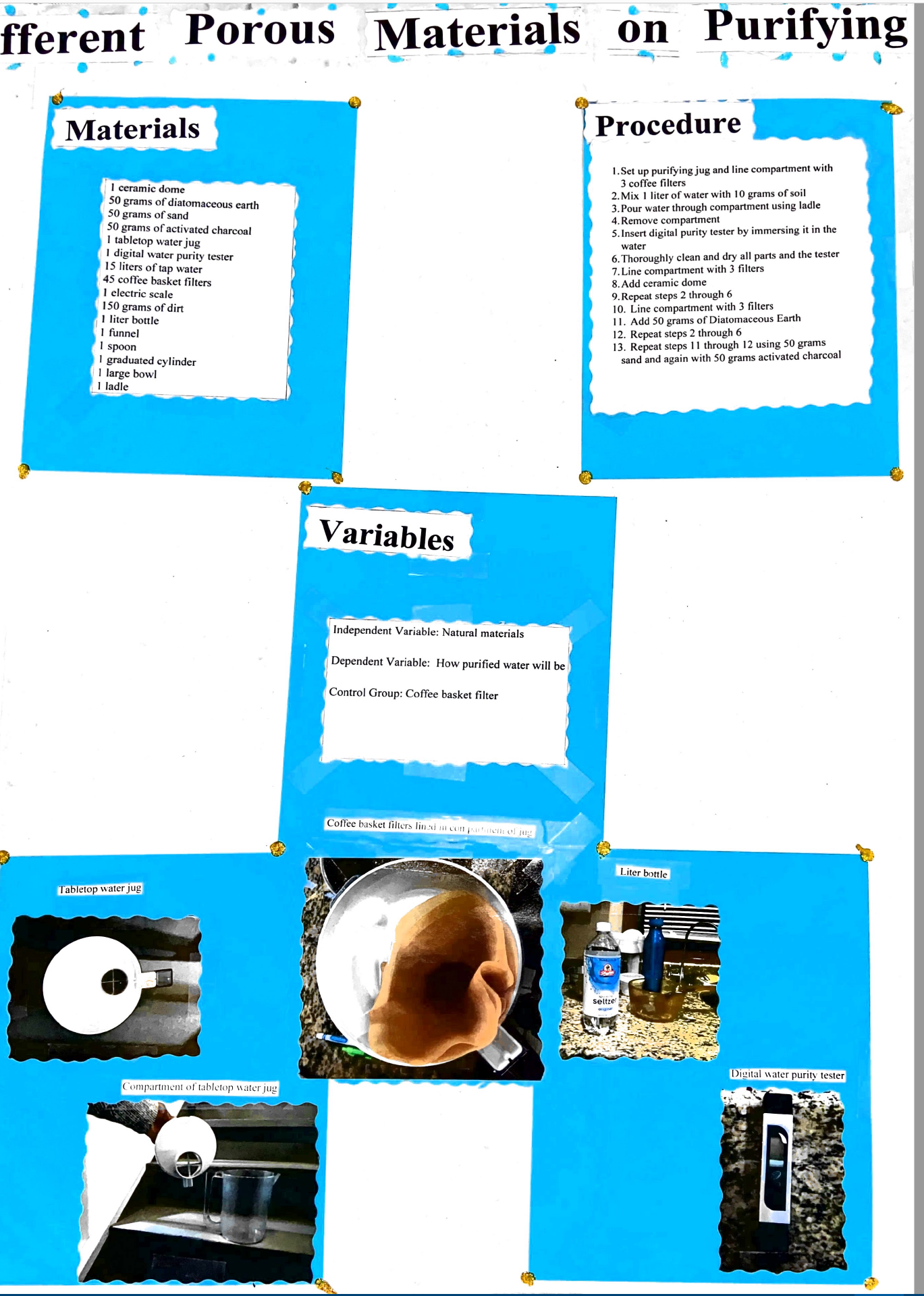The Effect of Different Porous Materials on Purifying Muddy Water
Abstract:
Do Porous Materials Affect Water Purity?
The purpose of the project was to determine which porous material was the most effective in purifying water. The hypothesis stated that if the material is more porous, then the more purified the water will be. A total of 15 liters of water and 150 grams of dirt were used in different filters to determine which filter was the best filter to purify muddy water. There were five levels in the experiment. They were diatomaceous earth, sand, activated charcoal, a ceramic dome, and coffee basket filters. The control group was the coffee basket filters used alone. Three replicates were performed at each level. Purity was measured by the total dissolved solids (TDS) in the water. The lower the ppm means fewer contaminants are present, and the purer the water is. It was measured in parts per million (ppm). A TDS meter was used to measure the purity. Based on the results, the hypothesis was accepted because the more porous the material was, the more purified the water was. The material which was the most porous was sand. Purity in this group was higher than in the control group.
Bibliography/Citations:
No additional citationsAdditional Project Information
Research Plan:
Title: The Effect of Different Porous Materials on Purifying Muddy Water
Question: What is the effect of different porous materials on purifying muddy water?
Hypothesis: If the material is more porous, then the more purified the water will be.
Materials:
1 ceramic dome, 50 grams of diatomaceous earth, 50 grams of sand, 50 grams of activated charcoal, 1 tabletop water jug, 1 digital purity tester, 15 liters of tap water, 45 coffee basket filters, 1 electric scale, 150 grams of dirt, 1-liter bottle, 1 funnel, 1 spoon, 1 graduated cylinder, 1 large bowl, 1 ladle
Procedure:
- Set up purifying jug and line compartment with 3 coffee filters
- Mix 1 liter of water with 10 grams of soil
- Pour water through compartment using ladle
- Remove compartment
- Insert digital purity tester by immersing it in the water
- Thoroughly clean and dry all jug parts and tester
- Reassemble the jug
- Line compartment with 3 filters
- Add ceramic dome
- Repeat steps 2 through 7
- Line compartment with 3 filters
- Add 50 grams of Diatomaceous Earth
- Repeat steps 2 through 7
- Repeat steps 11 and 12 using 50 grams sand and activated charcoal
Data Analysis: The purity of the water will be measured by a TDS meter. The purity of the water is the total dissolved solids in the water. The unit will be parts per million (ppm). A bar graph will be used to look for a trend in the data, with the materials on the x-axis and the ppm on the y-axis.
Risk Analysis: The water is not safe to drink and skin may get irritated. It is recommended to wear a long sleeve shirt, disposable gloves, and long pants during experimentation.
Works Cited
Brown, Julie. “Here's Why Diatomaceous Earth (DE) Swim Pool Filters Work so Well.” Here's Why Diatomaceous Earth (DE) Swim Pool Filters Work so Well, 27 Aug. 2015, 2:55 pm, blog.epminerals.com/heres-why-diatomaceous-earth-de-swim-pool-filters-work-so-well.
Contributors, HowStuffWorks.com. “What Is Activated Charcoal and Why Is It Used in Filters?” HowStuffWorks Science, HowStuffWorks, 8 Mar. 2018, science.howstuffworks.com/environmental/energy/question209.htm.
Duvauchelle, Joshua. “Natural Materials Used for Water Filtration.” LIVESTRONG.COM, Leaf Group, www.livestrong.com/article/165592-natural-materials-used-for-water-filtration/.
Guy, Filter. “Biological Water Filtration with Sand (Why Does It Work?).” Rain Water Harvesting and Slow Sand Water Filters, 6 Aug. 2013, www.enlight-inc.com/blog/?p=1359.
Woodard, John. “What Is a Ceramic Filter and How Does It Work?” Fresh Water Systems, 30 July 2019, www.freshwatersystems.com/blogs/blog/what-is-ceramic-filtration-and-how-does-it-work.

